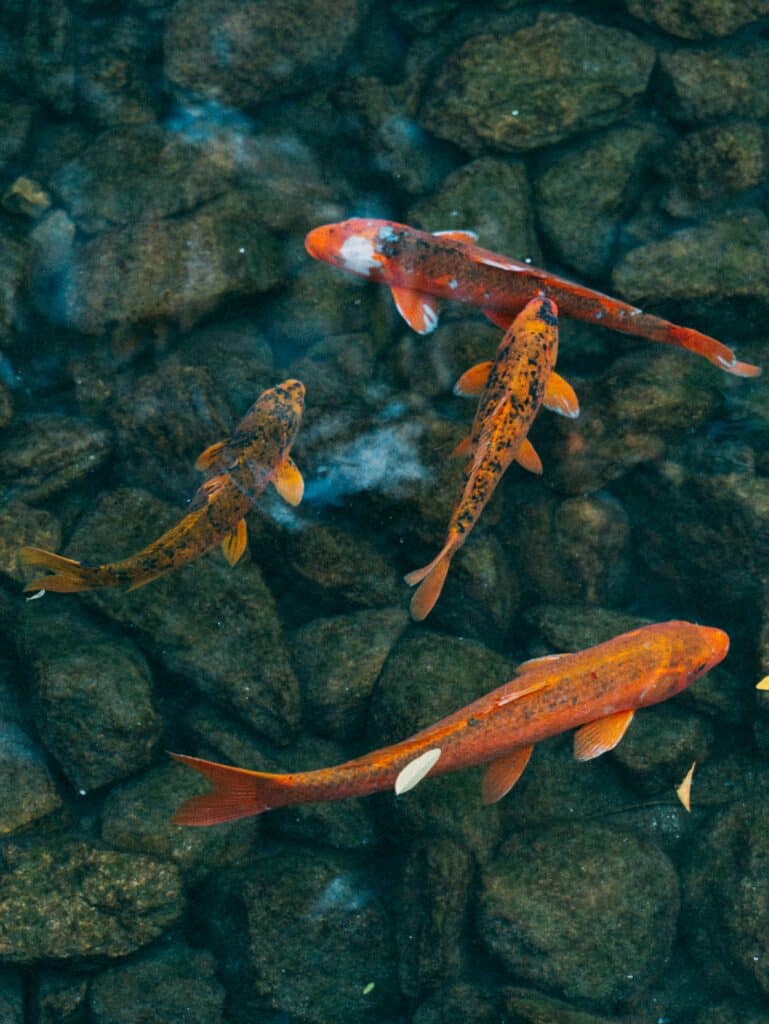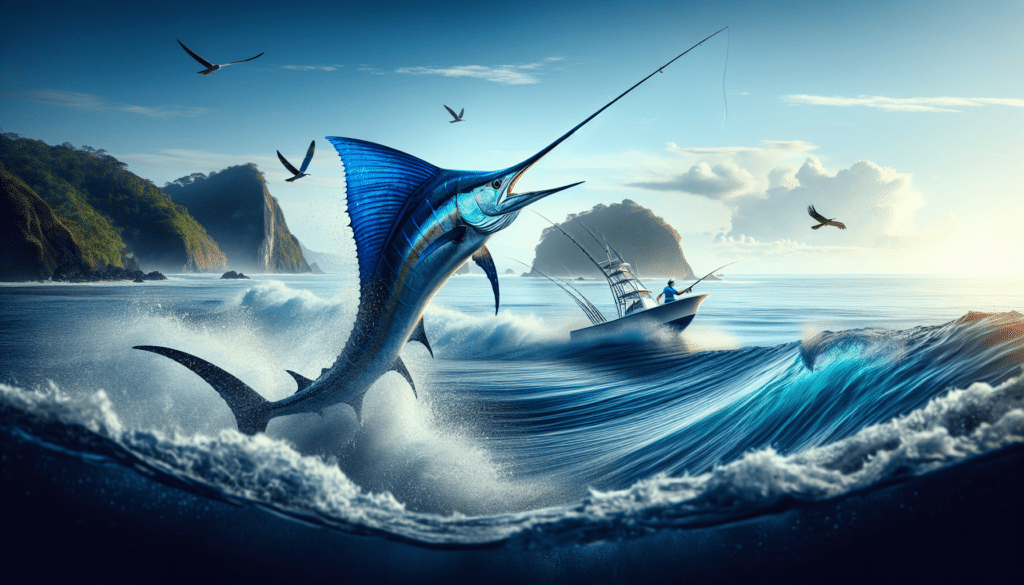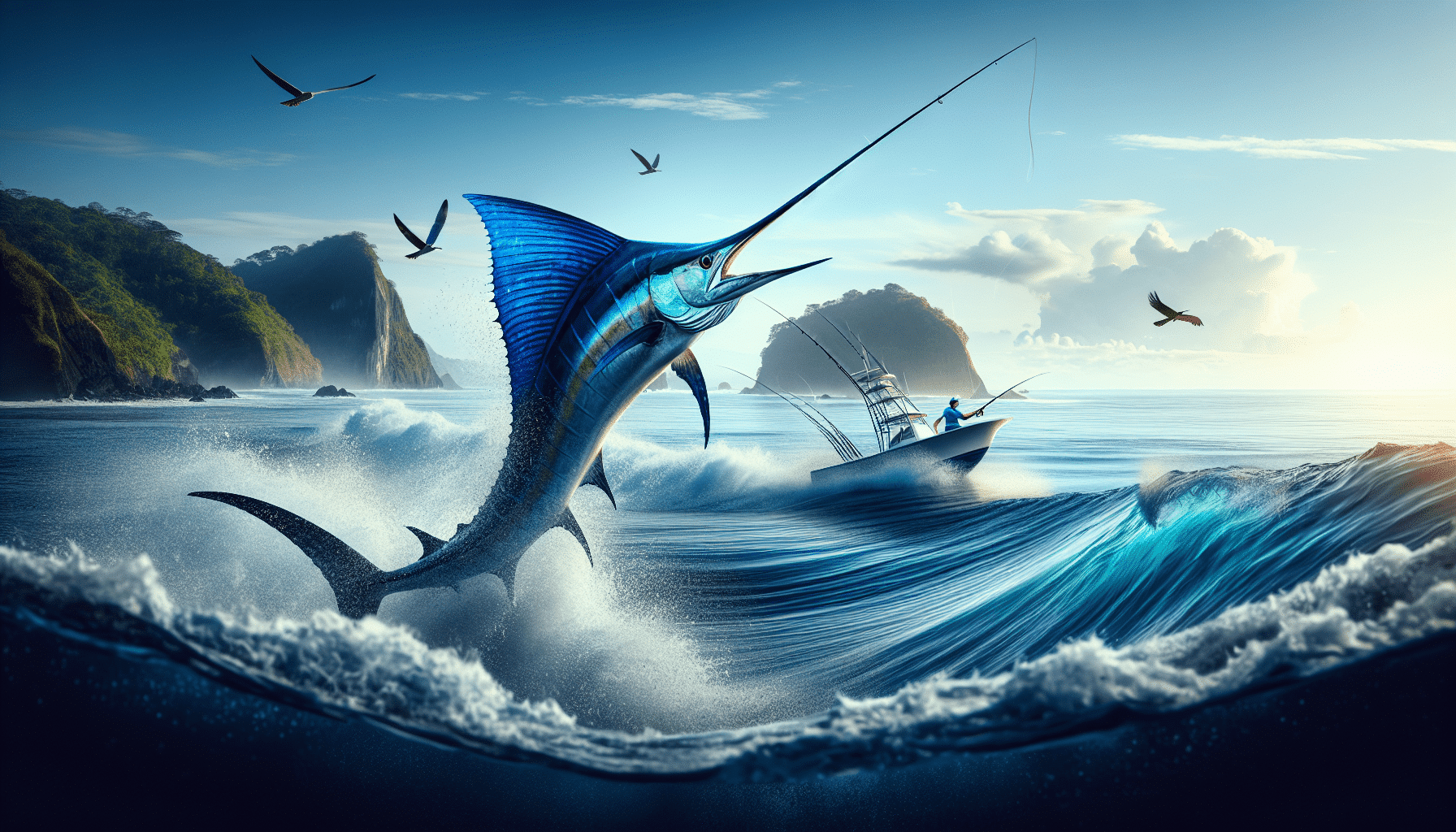If you’re eager to feel the thrill of battling a marlin on your line in the crystal-clear waters of Costa Rica, then this article is tailor-made for you. It’s all about charter fishing out of Flamingo Marina in Guanacaste, one of the prime locations worldwide for marlin fishing. The focus lies on essential tips and strategies proven to up your game and land you that prized catch. You’ll gather insights on everything from identifying marlin hotspots, understanding their behavior, to employing effective techniques, ensuring by the time you’ve finished reading, you’ll be ready to embark on the ultimate fishing adventure. Get ready to transform your marlin fishing journey in Costa Rica from merely good to downright spectacular.

Understanding Marlin Behavior
You may be biting at the bit to get started on your marlin fishing adventure, but it’s worth your time to first understand a little about the behavior of these magnificent fish. The more you know, the better prepared you’ll be.
Time of year marlin migrate to Costa Rica
Marlin, much like many other migratory species, make their way to the prosperous feeding grounds and warmer waters of Costa Rica during specific times of the year. Typically, marlin oceanic wanderers are spotted off the cost between May through October, though sightings can occur outside of these months. Understanding these migratory patterns can help you plan for peak fishing times.
Daily routine and feeding habits
Marlin spend their days navigating seas, utilizing their superior speed and agility to catch their preferred prey, which usually consist of various species of tuna and mackerel. Unlike some species, marlin don’t follow a strict feeding schedule. They eat when they’re hungry and when food is readily available. However, dawn and dusk often prove to be the best times for fishing as these are high-activity periods for most fish.
Preferred depth and water conditions of marlin
Contrary to popular belief, marlin aren’t solely deep-sea dwellers. While they do prefer water depths of around 70 to 100 fathoms, they’re known to move towards the surface in search of food, especially in warmer water conditions. The ideal temperature for these mighty sea creatures seems to range from 70 to 85 degrees Fahrenheit.
Choosing the Right Charter
With the marlin behavior under your belt, your next step is to choose the right charter for your fishing adventure. Not all are created equal, and some careful research and planning can ensure you pick the best one.
Researching reputable charter companies out of Flamingo Marina
Flamingo Marina in Guanacaste, Costa Rica, is home to numerous charter companies. Read reviews, check ratings, and ask for recommendations from other anglers to identify a reputable and reliable charter company. Look out for commentaries on the crew’s knowledge of marlin behavior, their fishing techniques, and their boat’s safety features.
Verifying charter includes necessary equipment and safety measures
Before booking, always verify what your charter includes. Does the package include all the gear you need? Is the equipment in good shape? Also, your safety on the water should be of paramount importance, so ensure the boat is equipped with all the necessary safety features like life jackets, first aid kits, radios, and GPS systems.
Reviewing charter prices and inclusions
Charter prices can vary greatly depending on the duration of the trip, size of the boat, and whether meals or drinks are included. Review the details carefully to ensure you’re getting what you signed up for.
Optimal Fishing Season in Costa Rica
Knowing the best times to fish for marlin can make the difference between a victorious day on the water and an uneventful one.
Understanding the impact of weather on marlin fishing
Much like us, marlin respond to weather changes. Stormy weather can make them more elusive, while calm sunny days can allow better visibility and conditions to cast your line. By keeping an eye on the weather and ocean conditions, you can strategically plan your fishing days.
Season with the highest marlin activity
While marlin can be caught throughout the year in Costa Rica, late summer to early fall typically sees the highest marlin activity. It’s worth noting that marlin fishing is a game of patience at any time of the year.
Considering off-peak seasons and rates
Lastly, if you’re on a budget or prefer less crowded fishing grounds, consider visiting during the off-peak seasons. Charter prices may be lower, and you might just have a better shot at reeling in a prized marlin with fewer boats around.
Learning Effective Trolling Techniques
When it comes to marlin, it’s all about the trolling. Mastering this method can drastically improve your chances of success.
Choosing the right trolling speed for marlin
Speed matters! Marlin are swift and agile, and your trolling speed should match. Typically, a speed of 7 to 9 knots is ideal. Too slow, and your bait won’t look appealing; too fast, and it may be hard for marlin to catch it.
Using proven trolling patterns
Trolling patterns play a crucial role in mimicking the natural movements of prey. A spread of lures placed at varying distances and depths can be highly effective. Remember, marlin are predators and are attracted to signs of distressed or injured prey.
Mastering the art of teaser fishing
Teaser fishing involves using hookless lures or baits to attract marlin to the surface. This method can be highly effective in triggering the marlin’s predatory instincts, following which you can cast your baited hook.

Using Appropriate Fishing Gear
Even the most experienced angler can’t catch marlin without the proper gear. Here’s what you need to know:
Understanding the importance of high-quality tackle
Marlins are strong, powerful creatures. Using sturdy, high-quality tackle not only lets you handle their force but also increases the odds of a successful catch.
Choosing the right fishing rods and reels
When battling marlin, your reel’s stamina should match yours. High-capacity reels with strong, resistant line are crucial. Likewise, the fishing rod must be sturdy enough to withstand a marlin’s vigorous fight yet flexible enough not to break under the strain.
Selecting effective bait and lures for marlin
Live bait such as mackerel or Bonito can be irresistible to marlin. However, artificial lures, especially ones that mimic the marlin’s favorite prey, can also be effective, not to mention practical and convenient as they’re easier to preserve on long fishing trips.
Recognizing Marlin Bites
Don’t lose your marlin because you didn’t recognize the signs of a bite. Here’s what to watch for:
Signs of a marlin bite
Marlin bites are usually marked by dramatic surface commotion. A splash or sudden tension on your line might indicate a marlin has taken a bite.
Differentiating between marlin bites and bites from other fish
Experience will help you distinguish a marlin bite from other fish. Generally, the strength and intensity of the pull will provide clues, as marlin are substantially stronger than most other species.
Reacting effectively to a marlin bite
A quick and appropriate reaction to a bite can be the difference between landing a marlin and watching it swim away. Give it a few extra seconds after the bite before reeling in to ensure the marlin has truly taken the bait.

Reeling and Landing Techniques
Getting the marlin to bite is only half the battle. You also need to know how to bring it onboard.
Applying correct reeling techniques for marlin
Knowing how to properly set your drag and when to reel in vs. letting the marlin run is vital. It’s a dance of sorts – one wrong step can mean game over.
Using the ‘pump and reel’ method
The ‘pump and reel’ technique can be particularly effective. It involves lifting the rod upward (or ‘pumping’) and then reeling in the slack as you lower the rod. This helps keep a steady tension on the line and tires the marlin, making it easier to reel in.
Safely landing a caught marlin
Safety should always come first, even when you’re about to land a prized marlin. It’s crucial to maintain a safe distance as marlin can cause injury with their sharp, spear-like bills. Leave the handling to the professional crew to avoid any risk.
Coordinates for Marlin Hotspots
Costa Rican waters are teeming with marlin hotspots, and knowing where to cast your line can give you an edge.
Collecting reliable marlin coordinates
Before heading out, research and collect reliable marlin coordinates. Talk to experienced local fishermen or your boat captain for insights on where marlin have been recently spotted.
Understanding GPS and chartplotter use
Knowing how to properly use a GPS and chartplotter can also significantly increase your odds of finding a hotspot. These tools not only provide accurate location data but can also track water temperatures, a key element when hunting for marlin.
Popular marlin hotspots in Guanacaste waters
Flamingo and Coco are among the top marlin fishing spots in Guanacaste waters. The plentiful food supply here attracts these predatory fish, making them a preferred choice for anglers.

Fishing Conservation Measures in Costa Rica
Safeguarding our marine life is a responsibility shouldered not only by Costa Rica but by every angler who casts a line in these waters.
Legislation influencing marlin fishing
Costa Rica has imposed numerous laws aimed at conserving marlin and other species. It’s important to be aware of and adhere to these regulations for sustainable fishing.
Practicing catch and release to preserve marlin populations
Catch and release practices are strongly encouraged to ensure the survival of the species. Consider taking a photograph of your catch and then releasing it back into the wild.
Understanding the role of anglers in marine conservation
As an angler, you play an instrumental role in marine conservation. By following the rules, respecting the sea, and teaching others to do the same, you can help ensure that future generations get to enjoy the thrill of marlin fishing.
Tips for a Successful Marlin Fishing Trip
Finally, some practical tips to help you make the most of your marlin fishing adventure.
Preparing for potential seasickness
Even seasoned sailors occasionally suffer from seasickness. Consider packing seasickness medication, and remember – staring at the horizon and getting plenty of fresh air can also help reduce nausea.
Packing essential items for a day trip
Being prepared is half the battle. Pack essentials like sunblock, hats, sunglasses, snacks, drinks, and extra clothing. You never know when you might need them!
Developing patience and perseverance for successful marlin fishing
Patience is key in fishing. You may not catch a marlin on your first trip, or even your second. But don’t be disheartened. The thrill of finally reeling in that massive marlin will be worth every second of your waiting game. Trust me on this!










0 Comments